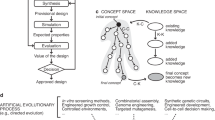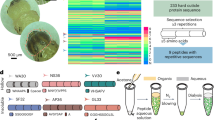Abstract
Enzyme activity is often dramatically reduced in polar organic solvents, even under conditions where the folded structures are stable. We have utilized random mutagenesis by polymerase chain reaction (PCR) techniques combined with screening for enhanced activity in the presence of dimethylformamide (DMF) to probe mechanisms by which improved enzymes for chemical synthesis in polar organic media might be obtained. Two amino acid substitutions which enhance subtilisin E activity in the presence of DMF, Q103R and D60N, were identified by screening on agar plates containing DMF and casein. The two substitutions are located near the substrate binding pocket or in the active site, and their effects on the catalytic efficiency kcat/KM for the hydrolysis of a peptide substrate are additive. The effects of D60N are apparent only in the presence of DMF, highlighting the importance of screening in the organic solvent. Protein engineering is an effective approach to enhancing enzyme activity in organic media: the triple mutant D60N+Q103R+N218S is 38 times more active than wild–type subtilisin E in 85% DMF. An evolutionary approach consisting of multiple steps of random muta–genesis and screening in continually higher concentrations of organic solvent should result in enzymes that are substantially more active in organic media.
This is a preview of subscription content, access via your institution
Access options
Subscribe to this journal
Receive 12 print issues and online access
$209.00 per year
only $17.42 per issue
Buy this article
- Purchase on Springer Link
- Instant access to full article PDF
Prices may be subject to local taxes which are calculated during checkout
Similar content being viewed by others
References
Dordick, J.S. 1989. Enzymatic catalysis in monophasic organic solvents. Enz. Microb. Technol. 11: 194–211.
Klibanov, A.M. 1986. Enzymes that work in organic solvents. Chemtech. June: 354–359.
Arnold, F.H. 1990. Enzyme engineering for non-aqueous solvents. Trends Biotechnol. 8: 244–249.
Martinez, P. and Arnold, F.H. 1991. Surface charge substitutions increase the stability of α-lytic protease in organic solvents. J. Am. Chem. Soc. 113: 6336–6337.
Chen, K., Robinson, A.C., Van Dam, M.E., Martinez, P., Economou, C. and Arnold, F.H. 1991. Enzyme engineering for nonaqueous solvents II. Additive effects of mutations on the stability and activity of subtilisin E in polar organic media. Biotechnol. Prog. 7: 125–129.
Martinez, P., Van Dam, M.E., Robinson, A.C., Chen, K. and Arnold, F.H. 1991. Stabilization of subtilisin E in organic solvents by site-directed mutagenesis. Biotechnol. & Bioeng. In press.
Barbas, C.F., III, Matos, J.R., West, J.B., Wong, C.H. 1988. A search for peptide ligase: cosolvent-mediated conversion of proteases to esterases for irreversible synthesis of peptides. J. Am. Chem. Soc. 110: 5162–5166.
Riva, S., Chopineau, J., Kieboom, A.P.G. and Klibanov, A.M. 1988. Protease-catalyzed regioselective esterification of sugars and related compounds in anhydrous dimethylformamide. J. Am. Chem. Soc. 110: 584–589.
Markland, Jr., F.S. and Smith, E.L. 1971. Primary structure, chemical and physical properties, p. 561–608. In: The Enzymes. 3rd ed., Vol. III. Boyer P.D. (Ed.). Academic Press, NY.
Kraut, J. 1971. Subtilisin: X-ray structure, p. 547–560. In: The Enzymes. 3rd ed., Vol. III.
Wells, J.A. and Estell, D.A. 1988. Subtilisin-an enzyme designed to be engineered. Trends Biochem. Sci. 13: 291–297.
Stahl, M.L. and Ferrari, E. 1984. Replacement of the Bacillus subtilis subtilisin structural gene with an in vitro-derived deletion mutation. J. Bacteriol. 158: 411–418.
Leung, D.W., Chen, E. and Goeddel, D.V. 1989. A method for random mutagenesis of a defined DNA segment using a modified polymerase chain reaction. Technique 1: 11–15.
Economou, C., Chen, K. and Arnold, F.H. 1991. Random mutagenesis to enhance the activity of subtilisin in organic solvents: Characterization of Q103R subtilisin E. Biotechnol. & Bioeng. In press.
Robertus, J.D., Kraut, J., Alden, R.A. and Birktoft, J.J. 1972. Subtilisin; a stereochemical mechanism involving transition-state stabilization. Biochemistry 23: 4293–4303.
Frommel, C. and Sander, C. 1989. Thermitase, a thermostable subtilisin: comparison of predicted and experimental structures and the molecular cause of thermostability. Proteins: Struct. Funct. Genet. 5: 22–37.
Bryan, P.N., Rollence, M.L., Pantoliano, M.W., Wood, J., Finzel, B.C., Gilliland, G.L., Howard, A.J. and Poulos, T.L. 1986. Proteases of enhanced stability: characterization of a thermostable variant of subtilisin. Proteins: struct., Funct., Genet. 1: 326–334.
Park, S.S., Wong, S.L., Wang, L.F. and Doi, R.H. 1989. Bacillus subtilis subtilisin gene (aprE) is expressed from σA (σ43) promoter in vitro and in vivo. J. Bacteriol. 171: 2657–2665.
Saiki, R.K., Gelfand, D.H., Stoffel, S., Scharf, S.J., Higuchi, R., Horn, G.T., Mullis, K.B. and Erlich, H.A. 1988. Primer-directed enzymatic amplification of DNA with a thermostable DNA polymerase. Science 239: 487–491.
Dubnau, D. and Davidoff-Abelson, R. 1971. Fate of transforming DNA following uptake by competent Bacillus subtilis. J. Mol. Biol. 56: 209–221.
Gryczan, T.J., Contente, S. and Dubnau, D. 1978. Characterization of Staphylococcus aureus plasmids introduced by transformation into Bacillus subtilis. J. Bacteriol. 134: 318–329.
Leighton, T.J. and Doi, R.H. 1971. The stability of messenger ribonucleic acid during sporulation in Bacillus subtilis. J. Biol. Chem. 246: 3189–3195.
Vieira, J. and Messing, J. 1987. Production of single-stranded plasmid DNA. Methods Enzymol. 153: 3–11.
Sanger, F., Nicklen, S. and Coulson, A.R. 1977. DNA sequencing with chain-terminating inhibitors. Proc. Natl. Acad. Sci. USA 74: 5463–5467.
Tabor, S. and Richardson, C.C. 1987. DNA sequence analysis with a modified bacteriophage T7 DNA polymerase. Proc. Natl. Acad. Sci. USA 84: 4767–4771.
Estell, D.A., Graycar, T.P. and Wells, J.A. 1985. Engineering an enzyme by site-directed mutagenesis to be resistant to chemical oxidation. J. Biol. Chem. 260: 6518–6521.
Laemmli, U.K. 1970. Cleavage of structural proteins during the assembly of the head of bacteriophage T4. Nature 227: 680–685.
Author information
Authors and Affiliations
Rights and permissions
About this article
Cite this article
Chen, K., Arnold, F. Enzyme Engineering for Nonaqueous Solvents: Random Mutagenesis to Enhance Activity of Subtilisin E in Polar Organic Media. Nat Biotechnol 9, 1073–1077 (1991). https://doi.org/10.1038/nbt1191-1073
Issue Date:
DOI: https://doi.org/10.1038/nbt1191-1073
This article is cited by
-
Protein Engineering of a Metalloprotease in Order to Improve Organic Solvents Stability and Activity
Catalysis Letters (2020)
-
Graphene oxide enabled long-term enzymatic transesterification in an anhydrous gas flux
Nature Communications (2019)
-
Synthetic evolution
Nature Biotechnology (2019)
-
The 2018 Nobel Prize in Chemistry: Engineering proteins (enzymes/peptide/antibodies) towards desired properties via the construction of random libraries
Science China Life Sciences (2019)
-
Exploring the full natural diversity of single amino acid exchange reveals that 40–60% of BSLA positions improve organic solvents resistance
Bioresources and Bioprocessing (2018)



